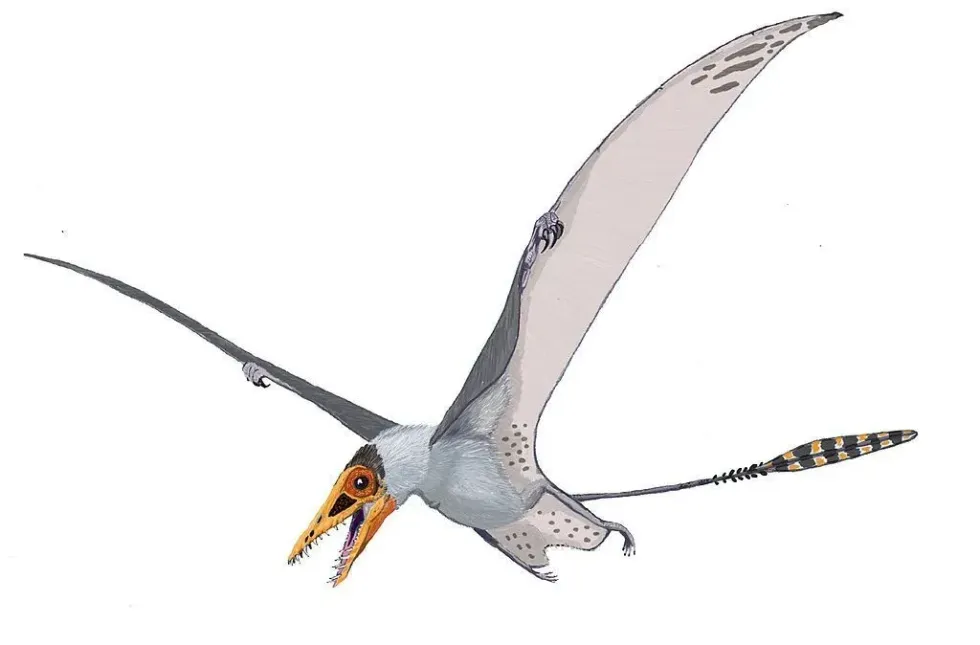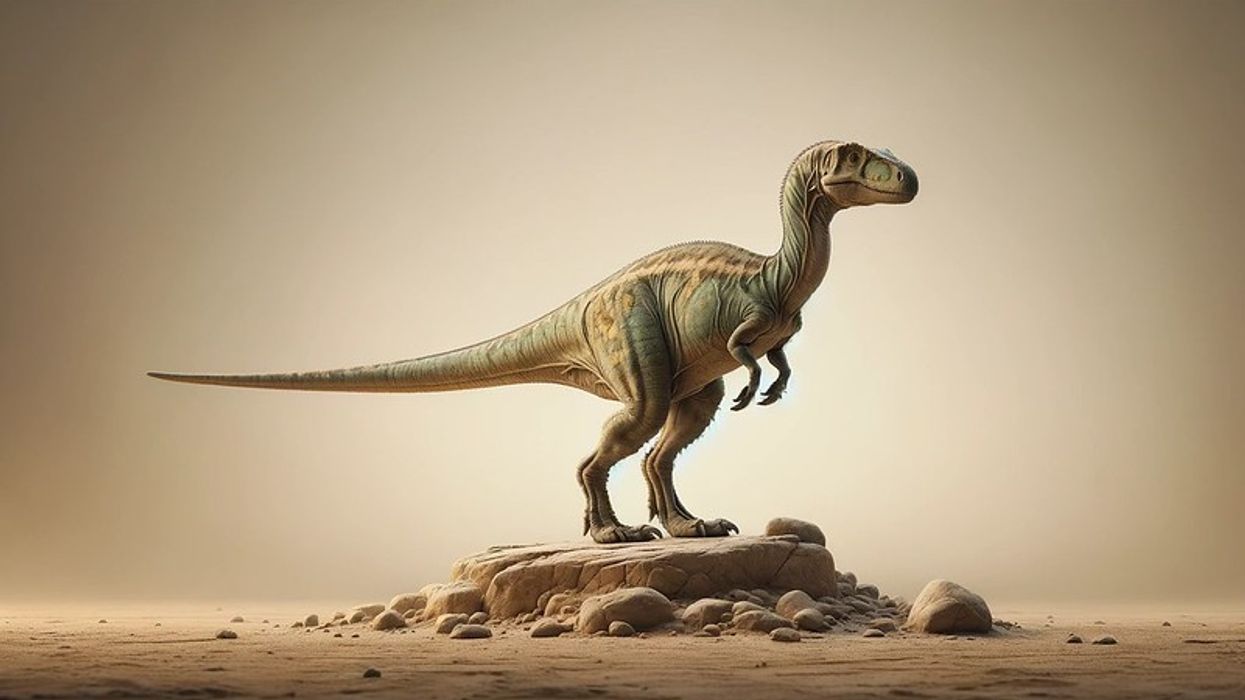This flying reptile, or pterosaur, lived about 150 million years ago in the Late Jurassic period. Sordes was first discovered in the 1960s in Kazakhstan’s Karabastau Svita and represent a primitive basal pterosaur.
It was a small toothed pterosaur with a long tail.
Sordes was a significant discovery and was discovered as a complete crushed skeleton on a slab. You'd be surprised to learn that the pterosaur is not considered to be a dinosaur since they were fliers and their front limbs stretched out to their sides.
The same applied to Sordes, which resembled a bat. However, it was a distant cousin to the dinosaur.
Not only are they the first reptiles to fly, but they were also the first vertebrates capable of flying. These pterosaurs of the Late Jurassic got their unfortunate name from Aleksandr Grigoorevich Sharov in 1971.
Ancestors of these species were believed to have had limbs initially but evolved over time into wings.
These wings further developed a skin-like thin membrane over them, similar to the one found in bats. These flying reptiles, with a wingspan of 23 in (58.4 cm), had a large head without any crests or horns and the tail was relatively long.
These flying reptiles, with a wingspan of 23 in (58.4 cm), had a large head without any crests or horns. The robust jaws of this species had large teeth towards the front of the jaw to make capturing preys easier.
The teeth in the Sordes' mouth were quite sharp and pointed, which would have made it easy for these species to tear apart the carcasses of their prey. These airborne predators had a largely carnivorous diet and they flew great distances in search of small insects and bugs as well as small amphibians like frogs, salamanders, and newts.
The sordes habitat was highly marine-oriented, making their homes in lakeshores, estuaries, and shorelines.
The genus name of this species, Sordes pilosus, roughly translates to filth or scum while 'pilosus' means hairy. So the literal meaning of this species was ' hairy filth'!
If you'd like to learn more about similar dinosaurs, check out our Nemicolopterus facts for kids or Tapejara facts that you're sure to love!
Sordes Interesting Facts
Was the Sordes a dinosaur?
Sordes was a pterosaur, not a dinosaur, even though they lived during the same period. Being pterosaurs, they were also considered to be flying reptiles. They were of great interest to paleontologists as they were the first pterosaurs to show evidence of a fur-like outer layer on their bodies.
How do you pronounce 'Sordes'?
This small pterosaur's name from Kazakhastan's Karabastau Svita is pronounced as 'Sor-dess'.
What type of prehistoric flying bird was a Sordes?
Sordes was a type of pterodactyloid pterosaur that was named by Aleksandr Grigorevich Sharov in 1971.
In which geological period did the Sordes live?
The Sordes pterosaur that had sharp teeth lived during the Late Jurassic period in parts of Asia, about 150 million years ago.
When did the Sordes become extinct?
They appeared during the Triassic period around 215 million years ago and thrived for 150 million years before going extinct at the end of the Cretaceous period.
Where did a Sordes live?
This small, toothed pterosaur with an unfortunate name lived in a marine environment like estuaries, shorelines, and shores of lakes.
What was a Sordes's habitat?
Sordes, named by A. G. Sharov, made their habitat in places that had water bodies near the land. This species, whose complete skeleton was found on a rock slab, was believed to have lived solitary lives since scientists and paleontologists have found their fossils separately in isolation and not in a group.
Who did a Sordes live with?
Sordes was believed by many scientists to have lived a solitary life, not mingling in groups but just being by themselves since the fossils located to date have all been in isolation.
How long did the Sordes live?
These flying reptiles would have lived for about 60-70 years, with the last specimen dying about 65 million years ago.
How did they reproduce?
Chemical analysis conducted by researchers and scientists on new fossil eggs of these pterosaurs has concluded that the female species laid soft shell eggs instead of the hard-shelled eggs that are normally laid by various other bird species. Since they were considered to be clumsy creatures, they laid their eggs on cliffs and islands.
Due to lack of evidence, there is not much known about the parental care the Sordes would have given their young.
However, certain studies claim that these flying reptiles, like modern reptiles, would have buried their eggs in the ground where the moisture could penetrate their eggs during incubation.
This, in turn, doubles the size of the young before hatching. The young Sordes' were also suspected to become independent at an early stage.
Sordes Fun Facts
What did a Sordes look like?

Sordes was originally described and named by A.G. Sharov in 1971. Its discovery caused quite the stir.
These flying reptiles, according to some scientists might have been the closest thing we'd have ever gotten to flying dragons. They had a short neck and a long tail that was over half their body length.
Resembling a bat, they too had a delicate membrane covering their wings. Apart from their long tails and bat-like wings, Sordes also had robust jaws with the teeth being designed in such a way that made crushing food easier. The teeth in the frontal half of the jaws are slightly big and pointed to enable efficient prey capture.
The teeth at the end of the jaw are smaller and more which made scientists believe that they were more useful for chewing and crushing the food. However, these animals did not have any horns or crests.
How many bones did a Sordes have?
Very little is known about the Sordes that lived during the Late Jurassic period in Asia, specifically Kazakhstan. Nonetheless, these flying reptiles with an unfortunate name would have definitely had over 50 bones!
How did they communicate?
These small pterosaurs would have communicated with each other using vocal and visual displays.
How big was the Sordes?
Sordes was about 12 in (30.4 cm) in height and was 18 in (45.7 cm) in length. They also had a wingspan of 23 in (58.4 cm). They weren't bigger than a present-day pigeon!
How fast could a Sordes move?
Although the exact speed they flew at is not known, these pterosaurs were efficient fliers! They had hollow bones like birds and their wings were so large that being on land was slightly more awkward and difficult for these creatures.
How much did a Sordes weigh?
Sordes weighed only around 1 lb (0.4 kg), the same as the weight of a football!
What were the male and female names of the species?
There are no sex-specific male or female names for this species.
What would you call a baby Sordes?
A baby Sordes was called a juvenile, just like the babies of all other pterosaur species!
What did they eat?
Considering their habitat, the Sordes diet consisted largely of insects like grasshoppers, ants, centipedes, salamanders, and small amphibians like frogs.
How aggressive were they?
These pterosaurs were not necessarily aggressive but they would have displayed a certain level of aggression if they, or their habitats, were threatened in any way.
Did you know...
During the 1990s, it was argued that this pterosaur didn’t have hair but instead scientists were misinterpreting the fibers of this animal’s flight membranes that were impressed into the specimens. However, that was later found out to be false and it was discovered that these animals did possess a coating of hair.
Why are they called Sordes?
These pterosaurs, that hard very sharp teeth, were given their genus name by Aleksandr Grigorevich Sharov in 1971. Even though it literally translates to 'hairy filth', Sharov insisted that 'Sordes' means 'devil' or 'evil spirit'.
Can Sordes fly?
Yes, Sordes could fly! In fact, they were known to be excellent fliers, flying over large distances with ease and looking for prey.
Here at Kidadl, we have carefully created lots of interesting family-friendly prehistoric animal facts for everyone to discover! Learn more about some other creatures from our Batrachognathus facts, or Peteinosaurus facts for kids.
You can even occupy yourself at home by coloring in one of our free printable Sordes coloring pages.










